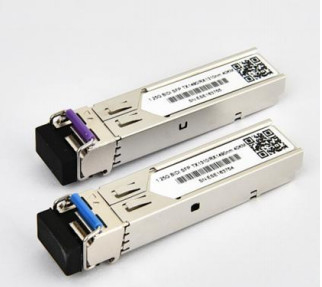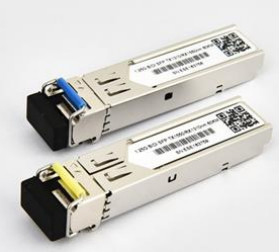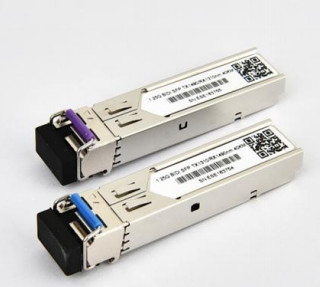1.25Gbps SFP Bi-Directional Transceiver, 40KM Reach Tx1310nm/Rx1490nm
Product Details:
| Place of Origin: | Guangdong, SHENZHEN |
| Brand Name: | TAKFLY |
| Certification: | CE,ROHS,REACH,ISO9001,ISO14001 |
| Model Number: | TK-Bxx92-3LCD20 |
Payment & Shipping Terms:
| Minimum Order Quantity: | 1 Pices |
|---|---|
| Price: | US$0.01 ~ US$1200/PC |
| Delivery Time: | 3-7working days |
| Payment Terms: | L/C, D/A, D/P, T/T, Western Union, MoneyGram |
|
Detail Information |
|||
| Ratio: | 50/50 | Center Wavelength: | 1450nm |
|---|---|---|---|
| Insertion Loss: | ≤0.3dB | Package Weight: | 10g |
| Package Type: | Bare Fiber, 900um Loose Tube, 2mm Cable | Wavelegth: | 1310nm |
| Axis Alignment: | Slow Axis Or Fast Axis | Wavelength Range: | 1310nm, 1550nm |
| Application: | Optical Communication Systems | Splitter Ratio: | 98/2 |
| Storage Temperature: | -40~+85℃ | Port Number: | 1x2 |
| Fiber Length: | 1m | Fiber: | PM Corning 980nm Fiber |
| Power Handling Capacity: | High Power | ||
| Highlight: | 40KM Reach SFP Bi-Directional Transceiver,1.25Gbps SFP Bi-Directional Transceiver,Tx1310nm/Rx1490nm SFP Bi-Directional Transceiver |
||
Product Description
- The SFP-BIDI transceivers are high performance, cost effective modules supporting dual data-rate of 1.25Gbps/1.0625Gbps and 40KM transmission distance with SMF.
- The transceiver consists of three sections: a DFB laser transmitter, a PIN photodiode integrated with a trans-impedance preamplifier (TIA) and MCU control unit. All modules satisfy class I laser safety requirements.
- The transceivers are compatible with SFP Multi-Source Agreement (MSA) and SFF-8472. For further information, please refer to SFP MSA.
Features
- Dual data-rate of 1.25Gbps/1.063Gbps operation
- 1310nm DFB laser and PIN photodetector for 40KM transmission
- Compliant with SFP MSA and SFF-8472 with simplex LC receptacle
- Digital Diagnostic Monitoring: Internal Calibration or External Calibration
- Compatible with SONET OC-24-LR-1
- Compatible with RoHS
- +3.3V single power supply
- Operating case temperature range: 0 °C to +70 °C (Commercial) / -40 °C to +85 °C (Industrial)
Applications
- Gigabit Ethernet
- Fiber Channel
- Switch to Switch interface
- Switched backplane applications
- Router/Server interface
- Other optical transmission systems
Module Block Diagram
![]()
Absolute Maximum Ratings
| Parameter | Symbol | Min | Typ | Max | Unit | Ref. |
| Maximum Supply Voltage | Vcc | -0.5 | 4.7 | V | ||
| Storage Temperature | TS | -40 | 85 | °C | ||
| Case Operating Temperature | TOP | 0 | 70 | °C |
Electrical Characteristics (TOP = 0 to 70℃, VCC = 3.15 to 3.60Volts)
| Parameter | Symbol | Min | Typ | Max | Unit | Ref. |
| Supply Voltage | Vcc | 3.15 | 3.3 | 3.6 | V | |
| Supply Current | Icc | 185 | 280 | mA | ||
| Transmitter | ||||||
| Input differential impedance | Rin | 100 | Ω | 1 | ||
| Single ended data input swing | Vin,pp | 250 | 1200 | mV | ||
| Transmit Disable Voltage | VD | Vcc–1.3 | Vcc | V | ||
| Transmit Enable Voltage | VEN | Vee | Vee+ 0.8 | V | 2 | |
| Transmit Disable Assert Time | 10 | us | ||||
| Receiver | ||||||
| Single ended data output swing | Vout,pp | 250 | 800 | mV | 3 | |
| Data output rise time | tr | 100 | 175 | ps | 4 | |
| Data output fall time | tf | 100 | 175 | ps | 4 | |
| LOS Fault | VLOS fault | Vcc–0.5 | VccHOST | V | 5 | |
| LOS Normal | VLOS norm | Vee | Vee+0.5 | V | 5 | |
| Power Supply Rejection | PSR | 100 | mVpp | 6 |
Notes:
- Connected directly to TX data input pins. AC coupled thereafter
- Or open circuit.
- Into 100 ohms differential termination.
- 20 – 80 %
- Loss Of Signal is LVTTL. Logic 0 indicates normal operation; logic 1 indicates no signal detected.
- Receiver sensitivity is compliant with power supply sinusoidal modulation of 20 Hz to 1.5 MHz up to specified value applied through the recommended power supply filtering network.
Electrical Input / Output Characteristics
| Parameter | Symbol | Min. | Typ | Max. | Unit | Note | |
| Diff. input voltage swing | 120 | 820 | mVpp | 1 | |||
|
Tx Disable input |
H | VIH | 2.0 | Vcc+0.3 |
V |
||
| L | VIL | 0 | 0.8 | ||||
|
Tx Fault output |
H | VOH | 2.0 | Vcc+0.3 |
V |
2 |
|
| L | VOL | 0 | 0.8 | ||||
| Input Diff. Impedance | Zin | 100 | Ω | ||||
| Parameter | Symbol | Min. | Typ | Max. | Unit | Note | |
| Diff. output voltage swing | 340 | 650 | 800 | mVpp | 3 | ||
|
Rx LOS Output |
H | VOH | 2.0 | Vcc+0.3 | V |
2 |
|
| L | VOL | 0 | 0.8 | ||||
Notes:
1. TD+/- are internally AC coupled with 100Ω differential termination inside the module.
2. Tx Fault and Rx LOS are open collector outputs, which should be pulled up with 4.7k to 10kΩ resistors on the host board. Pull up voltage between 2.0V and Vcc+0.3V.
3. RD+/- outputs are internally AC coupled, and should be terminated with 100Ω (differential) at the user SERDES
Optical Characteristics
Transmitter
| Parameter | Symbol | Min. | Typ | Max. | Unit | Note |
| Operating Wavelength | λC | 1260 | 1310 | 1360 | nm | |
| Ave. output power (Enabled) | Po | -5 | 0 | dBm | 1 | |
| Extinction Ratio | ER | 10 | dB | 1 | ||
| RMS spectral width | Δλ | 4 | nm | |||
| Rise/Fall time (20%~80%) | Tr/Tf | 0.26 | ps | 2 | ||
| Output Eye Mask | Telcordia GR-253-CORE and ITU-T G.957 compatible | |||||
1. Measure at 2^23-1 NRZ PRBS pattern
2. Transmitter eye mask definition
| Parameter | Symbol | Min. | Typ | Max. | Unit | Note |
| Operating Wavelength | 1470 | 1510 | nm | |||
| Sensitivity | Psen | -24 | dBm | 1 | ||
| Min. overload | Pimax | -3 | dBm | |||
| LOS Assert | Pa | -36 | dBm | |||
| LOS De-assert | Pd | -30 | dBm | 2 | ||
| LOS Hysteresis | Pd-Pa | 0.5 | 6 | dB |
1. Measured with Light source 1310nm (1490nm), ER=10dB; BER =<10^-12 @PRBS=2^23-1 NRZ.
2. When LOS de-asserted, the RX data+/- output is signal output.
Pin Definitions and Functions
![]()
| PIN | Name | Function | Notes | |
| 1 | VeeT | Tx ground | ||
| 2 | Tx Fault | Tx fault indication, Open Collector Output, active “H” | 1 | |
| 3 | Tx Disable | LVTTL Input, internal pull-up, Tx disabled on “H” | 2 | |
| 4 | MOD-DEF2 | 2 wire serial interface data input/output (SDA) | 3 | |
| 5 | MOD-DEF1 | 2 wire serial interface clock input (SCL) | 3 | |
| 6 | MOD-DEF0 | Model present indication | 3 | |
| 7 | Rate select | No connection | ||
| 8 | LOS | Rx loss of signal, Open Collector Output, active “H” | 4 | |
| 9 | VeeR | Rx ground | ||
| 10 | VeeR | Rx ground | ||
| 11 | VeeR | Rx ground | ||
| 12 | RD- | Inverse received data out | 5 | |
| 13 | RD+ | Received data out | 5 | |
| 14 | VeeR | Rx ground | ||
| 15 | VccR | Rx power supply | ||
| 16 | VccT | Tx power supply | ||
| 17 | VeeT | Tx ground | ||
| 18 | TD+ | Transmit data in | 6 | |
| 19 | TD- | Inverse transmit data in | 6 | |
| 20 | VeeT | Tx ground |
Notes:
- When high, this output indicates a laser fault of some kind. Low indicates normal operation. And should be pulled up with a 4.7 – 10KΩ resistor on the host board.
- TX disable is an input that is used to shut down the transmitter optical output. It is pulled up within the module with a 4.7 – 10KΩ resistor. Its states are:
Low (0 – 0.8V): Transmitter on (>0.8, < 2.0V): Undefined
High (2.0V~Vcc+0.3V): Transmitter Disabled Open: Transmitter Disabled
Mod-Def 0,1,2. These are the module definition pins. They should be pulled up with a 4.7K – 10KΩ resistor on the host board. The pull-up voltage shall be VccT or VccR.
Mod-Def 0 has been grounded by the module to indicate that the module is present Mod-Def 1 is the clock line of two wire serial interface for serial ID
Mod-Def 2 is the data line of two wire serial interface for serial ID
When high, this output indicates loss of signal (LOS). Low indicates normal operation.
RD+/-: These are the differential receiver outputs. They are AC coupled 100Ω differential lines which should be terminated with 100Ω (differential) at the user SERDES. The AC coupling is done inside the module and is thus not required on the host board.
TD+/-: These are the differential transmitter inputs. They are AC-coupled, differential lines with 100Ω differential termination inside the module. The AC coupling is done inside the module and is thus not required on the host board.
Digital Diagnostic Functions
TAKFLY TK-B3424-3LCD40 transceivers support the 2-wire serial communication protocol as defined in the SFP MSA. It is very closely related to the E2PROM defined in the GBIC standard, with the same electrical specifications.
The standard SFP serial ID provides access to identification information that describes the transceiver’s capabilities, standard interfaces, manufacturer, and other information.
Additionally, TAKFLY SFP transceivers provide a unique enhanced digital diagnostic monitoring interface, which allows real-time access to device operating parameters such as transceiver temperature, laser bias current, transmitted optical power, received optical power and transceiver supply voltage. It also defines a sophisticated system of alarm and warning flags, which alerts end-users when particular operating parameters are outside of a factory set normal range.
The SFP MSA defines a 256-byte memory map in E2PROM that is accessible over a 2-wire serial interface at the 8bit address 1010000X (A0h). The digital diagnostic monitoring interface makes use of the 8 bit address 1010001X (A2h), so the originally defined serial ID memory map remains unchanged. The interface is identical to, and is thus fully backward compatible with both the GBIC Specification and the SFP Multi Source Agreement.
The operating and diagnostics information is monitored and reported by a Digital Diagnostics Transceiver Controller (DDTC) inside the transceiver, which is accessed through a 2-wire serial interface. When the serial protocol is activated, the serial clock signal (SCL, Mod Def 1) is generated by the host. The positive edge clocks data into the SFP transceiver into those segments of the E2PROM that are not write-protected. The negative edge clocks data from the SFP transceiver. The serial data signal (SDA, Mod Def 2) is bi-directional for serial data transfer. The host uses SDA in conjunction with SCL to mark the start and end of serial protocol activation. The memories are organized as a series of 8-bit data words that can be addressed individually or sequentially.Digital diagnostics for the TK-B3424-3LCD40 are Internally calibrated by default.
Typical Interface Circuit
![]()
Package Dimensions
![]()
Regulatory Compliance
| Feature | Reference | Performance | |
| Electrostatic discharge (ESD) | IEC/EN 61000-4-2 | Compatible with standards | |
| Electromagnetic Interference (EMI) | FCC Part 15 Class B EN 55022 Class B (CISPR 22A) | Compatible with standards | |
| Laser Eye Safety | FDA 21CFR 1040.10, 1040.11 IEC/EN 60825-1, 2 | Class 1 laser product | |
| Component Recognition | IEC/EN 60950, UL | Compatible with standards | |
| ROHS | 2002/95/EC | Compatible with standards | |
| EMC | EN61000-3 | Compatible with standards | |





